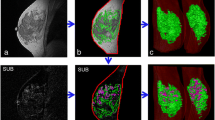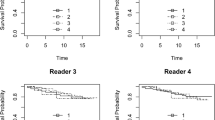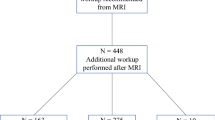Abstract
Objective
The objective of this study was to evaluate the effect of bilateral salpingo-oophorectomy (BSO) on background parenchymal enhancement (BPE) and the amount of fibroglandular tissue (FGT) seen on breast MRI.
Methods
Retrospective review identified 21 BRCA mutation carriers who underwent breast MRI before and after elective BSO. After exclusion of patients placed on postoperative hormone replacement therapy, there were 18 eligible patients. Blinded to surgical status, three independent readers used categorical scales to rate BPE (minimal, mild, moderate, marked) and the amount of FGT (fatty, scattered, heterogeneously dense, dense) on pre- and post-BSO MRI examinations. The sign test was used to assess for changes in the categorical ratings of BPE and FGT.
Results
Significant proportions of women demonstrated decreases in BPE and in the amount of FGT following oophorectomy (P = 0.004 and 0.02, respectively.) BPE decreases were larger and seen earlier than FGT changes. There was no significant relationship between age/body mass index and changes in BPE and FGT.
Conclusions
BPE and the amount of FGT seen on breast MRI are significantly decreased by oophorectomy; BPE decreases to a greater extent and earlier than FGT.
Key Points
• Background parenchymal enhancement significantly decreases at breast MRI following oophorectomy.
• Fibroglandular tissue significantly decreases on breast MRI following oophorectomy.
• Decrease in background parenchymal enhancement is greater than in fibroglandular tissue.
• Decrease in background parenchymal enhancement occurs earlier than in fibroglandular tissue.



Similar content being viewed by others
References
Saslow D, Boetes C, Burke W et al (2007) American Cancer Society guidelines for breast screening with MRI as an adjunct to mammography. CA Cancer J Clin 57:75–89
Antoniou A, Pharoah PD, Narod S et al (2003) Average risks of breast and ovarian cancer associated with BRCA1 or BRCA2 mutations detected in case Series unselected for family history: a combined analysis of 22 studies. Am J Hum Genet 72:1117–1130
Chen S, Parmigiani G (2007) Meta-analysis of BRCA1 and BRCA2 penetrance. J Clin Oncol : Off J Am Soc Clin Oncol 25:1329–1333
Morris EA (2007) Diagnostic breast MR imaging: current status and future directions. Radiol Clin N Am 45:863–880, vii
Kuhl CK, Bieling HB, Gieseke J et al (1997) Healthy premenopausal breast parenchyma in dynamic contrast-enhanced MR imaging of the breast: normal contrast medium enhancement and cyclical-phase dependency. Radiology 203:137–144
Muller-Schimpfle M, Ohmenhauser K, Stoll P, Dietz K, Claussen CD (1997) Menstrual cycle and age: influence on parenchymal contrast medium enhancement in MR imaging of the breast. Radiology 203:145–149
Hussain Z, Roberts N, Whitehouse GH, Garcia-Finana M, Percy D (1999) Estimation of breast volume and its variation during the menstrual cycle using MRI and stereology. B J Radiol 72:236–245
Graham SJ, Stanchev PL, Lloyd-Smith JO, Bronskill MJ, Plewes DB (1995) Changes in fibroglandular volume and water content of breast tissue during the menstrual cycle observed by MR imaging at 1.5 T. J Magn Reson Imaging : JMRI 5:695–701
Delille JP, Slanetz PJ, Yeh ED, Kopans DB, Halpern EF, Garrido L (2005) Hormone replacement therapy in postmenopausal women: breast tissue perfusion determined with MR imaging—initial observations. Radiology 235:36–41
Harvey JA, Santen RJ, Petroni GR et al (2008) Histologic changes in the breast with menopausal hormone therapy use: correlation with breast density, estrogen receptor, progesterone receptor, and proliferation indices. Menopause 15:67–73
Pfleiderer SO, Sachse S, Sauner D et al (2004) Changes in magnetic resonance mammography due to hormone replacement therapy. Breast Cancer Res : BCR 6:R232–R238
King V, Gu Y, Kaplan JB, Brooks JD, Pike MC, Morris EA (2012) Impact of menopausal status on background parenchymal enhancement and fibroglandular tissue on breast MRI. Eur Radiol 22:2641–2647
King V, Kaplan J, Pike MC et al (2012) Impact of tamoxifen on amount of fibroglandular tissue, background parenchymal enhancement, and cysts on breast magnetic resonance imaging. Breast J 18:527–534
Eng-Wong J, Orzano-Birgani J, Chow CK et al (2008) Effect of raloxifene on mammographic density and breast magnetic resonance imaging in premenopausal women at increased risk for breast cancer. Cancer Epidemiol Biomark Prev : Publ Am Assoc Cancer Res Cosponsored Am Soc Prev Oncol 17:1696–1701
King V, Goldfarb SB, Brooks JD et al (2012) Effect of aromatase inhibitors on background parenchymal enhancement and amount of fibroglandular tissue at breast MR imaging. Radiology 264:670–678
King V, Brooks JD, Bernstein JL, Reiner AS, Pike MC, Morris EA (2011) Background parenchymal enhancement at breast MR imaging and breast cancer risk. Radiology 260:50–60
D'Orsi CJ, Mendelson EB, Ikeda DM et al (2003) Breast Imaging Reporting and Data System: ACR BI-RADS—Breast Imaging Atlas. American College of Radiology, Reston, VA
Landis JR, Koch GG (1977) The measurement of observer agreement for categorical data. Biometrics 33:159–174
Rebbeck TR, Kauff ND, Domchek SM (2009) Meta-analysis of risk reduction estimates associated with risk-reducing salpingo-oophorectomy in BRCA1 or BRCA2 mutation carriers. J Natl Cancer Inst 101:80–87
Fakkert IE, Mourits MJ, Jansen L et al (2012) Breast cancer incidence after risk-reducing salpingo-oophorectomy in BRCA1 and BRCA2 mutation carriers. Cancer Prev Res (Phila) 5:1291–1297
Berliner JL, Fay AM (2007) Risk assessment and genetic counseling for hereditary breast and ovarian cancer: recommendations of the National Society of Genetic Counselors. J Genet Couns 16:241–260
Ciatto S, Houssami N, Apruzzese A et al (2005) Categorizing breast mammographic density: intra- and interobserver reproducibility of BI-RADS density categories. Breast 14:269–275
Author information
Authors and Affiliations
Corresponding author
Rights and permissions
About this article
Cite this article
Price, E.R., Brooks, J.D., Watson, E.J. et al. The Impact of Bilateral Salpingo-Oophorectomy on Breast MRI Background Parenchymal Enhancement and Fibroglandular Tissue. Eur Radiol 24, 162–168 (2014). https://doi.org/10.1007/s00330-013-2993-9
Received:
Revised:
Accepted:
Published:
Issue Date:
DOI: https://doi.org/10.1007/s00330-013-2993-9




